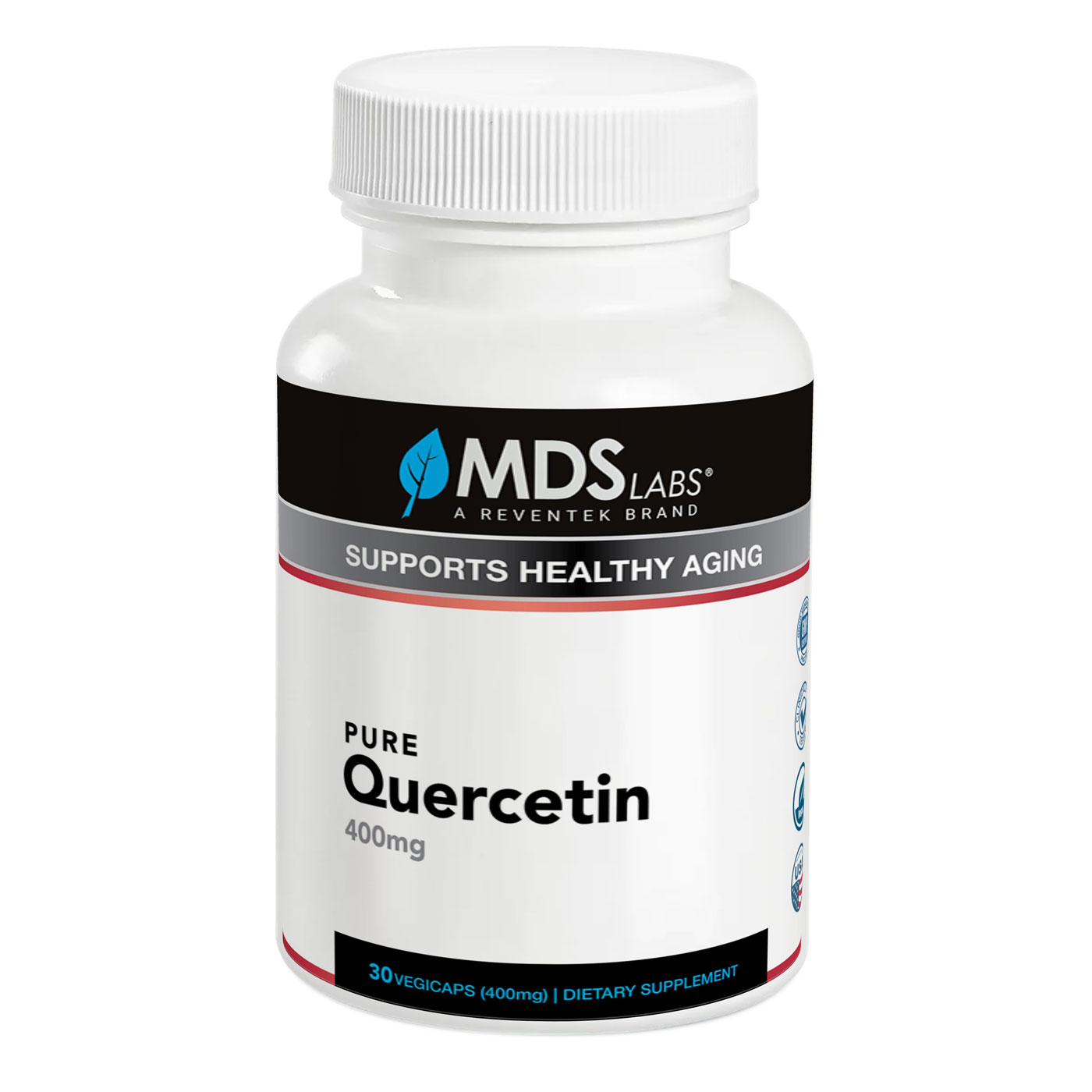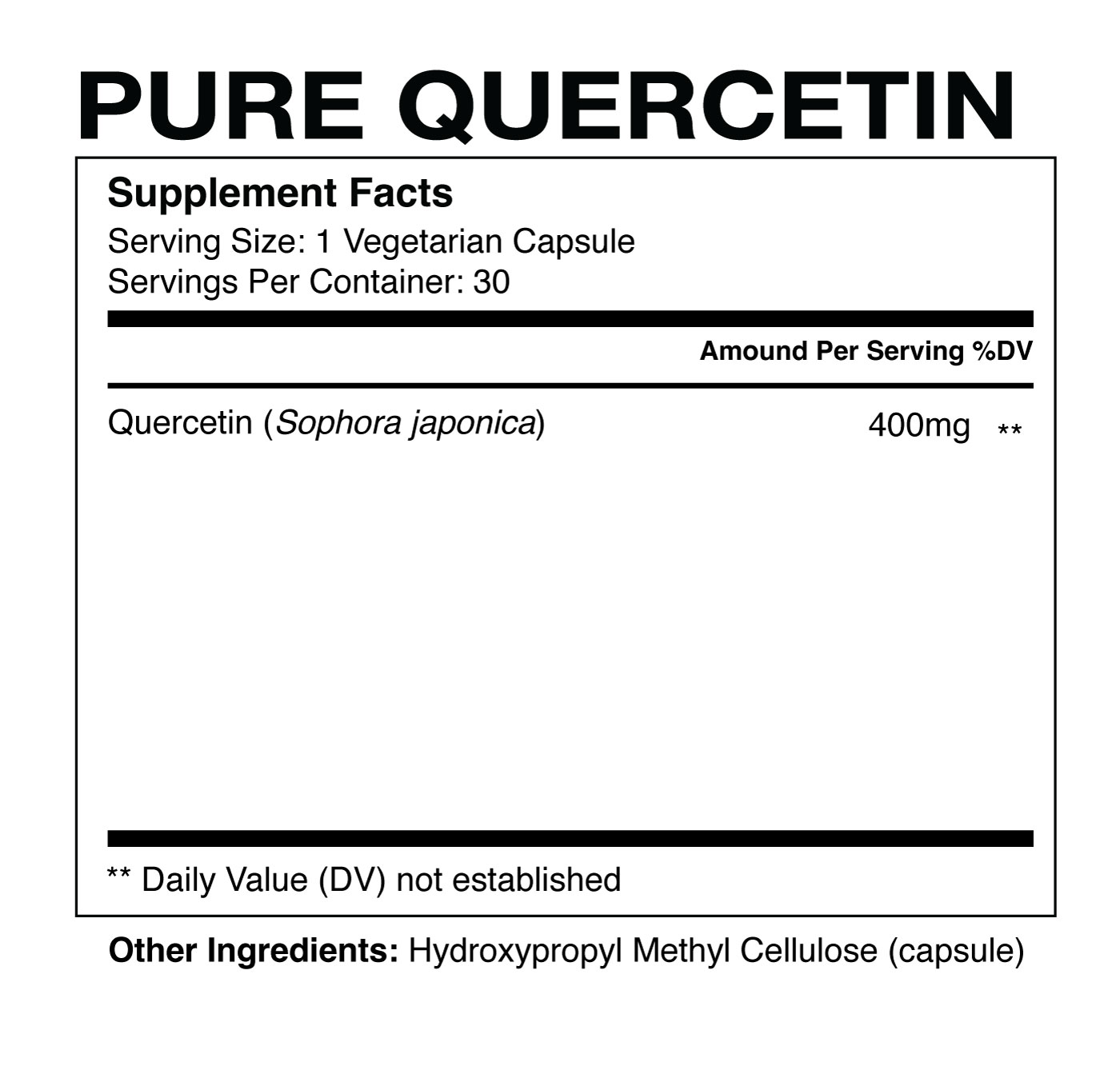Pure Quercetin
From Sophora japonica
400mg Vegan Capsules
- 99% Pure Quercetin Isolate
- Senolytic / Senomorphic Support*
- Supports Cardiometabolic, Cellular and Immune Response*
- Promotes Neuroprotection*
- Natural, Gluten Free, Vegan, Non GMO
Quercetin: A Powerful Flavinoid with Antioxidant and Neuroprotective Properties*
Quercetin is a naturally occurring flavonoid found in many fruits, vegetables, grains, and leaves, and is also found abundantly in onions, apples, berries, and tea. It's celebrated for its potent antioxidant properties, which combat oxidative stress and inflammation, key contributors to aging and chronic diseases.* Human and animal experiments have provided supportive evidence for the neuroprotective effects of quercetin, either against neurotoxic chemicals or in various models of neuronal injury and neurodegenerative diseases.* [1] Notably, quercetin is combined with the anti-cancer drug Dasatinib to formulate the D+Q senolytic treatment.
It is hypothesized that quercetin may act by having both a direct antioxidant effect, and might stimulate our cellular defenses against oxidative stress. It is thought to accomplish this by inducing the Nrf2-ARE and PON2 signaling pathways.* Additionally, Surtuin (SIRT1) activation by quercetin has been shown to induce autophagy, the process by which the proteasome enzyme acts as the body's own clean-up crew, breaking down and destroying old, damaged, or abnormal cells, also known as senescent cells.* [1]

the Accumulation of Senescent Cells as we Age
As we get older, our immune system slows down, leading to an accumulation of these senescent cells. They can impair the function of healthy cells, affecting our resilience to stress and illness. Cellular senescence is a major driver of age-related chronic disease and geriatric syndromes, including cognitive decline. Senotherapeutics are a rapidly emerging treatment within the field of anti-aging research, designed to target and eliminate these senescent cells, and support the regeneration of new tissue. Senotherapeutics are divided into two classes, senolytics and senomorphics. [2]

senotherapeutics: senolytics & senomorphics
Senolytics can selectively target and kill senescent cells. The majority of known senolytics, for example, Dasatinib + Quercetin (D+Q), eliminate these cells by targeting critical enzymes associated with pro-survival and anti-apoptic (anti cell death) mechanisms, specifically the Bcl-2 signaling pathway. Senolytics have demonstrated the ability to alleviate many chronic ailments such as atherosclerosis and liver fibrosis, providing a measurable increase in healthspan. Several natural compounds, such as fisetin, curcumin, and piperlogumine might share these properties, through targeting various signaling pathways.* [2] Senolytics are considered apoptotic (senoptosis). Apoptosis is an important biological function in the life cycle of a cell. It is used in the body to get rid of cells that are unneeded, abnormal, or damaged beyond repair.
Alternatively, senomorphics can reduce the inflammatory signaling secreted by damaged cells. They target different enzymes, including NF-kB, IL-1a, MAPK and others. Although senomorphics are less popular than senolytics, they may be a preferred method of intervention, as senescent cells are also implicated in processes such as wound healing and development. [2] Several senomorphic compounds, such as Rapamycin, which targets mTOR, Nrf2, and NF-kB, and Metformin, which also targets mTOR, and activates AMPK, are thought to have powerful anti-aging properties.* Rapamycin is the only known compound that has demonstrated the ability to extend lifespan in all mammals. [3] Senomorphics are known as being nonapoptotic (senolysis), given that they work to reduce the inflammatory signaling from senescent cells, not the cells themselves. This prevents more cells from becoming senescent.

Quercetin: Both a Senolytic and a Senomorphic*
A fascinating aspect of Quercetin is that it is thought to share both senolytic, and senomorphic properties.* Its senomorphic action comes from its ability to activate proteasomes- these are barrel-shaped protein complexes that break down unwanted cells.* When a protein is marked for destruction, enzymes patrol the cell and tag it with a chemical marker that the proteasome recognizes. The proteasome then unfolds the protein, stuffs it into a chamber, and cuts it into pieces that the cell can reuse to make new proteins. [4] Quercetin’s status as a senolytic comes from its ability to inhibit the SRC family kinase (SRC, FYN, LYN), BCL-2, PI3K isoform, and AKT kinase enzymes.* AKT signaling pathways also play an important part in aging and anti-aging, and studies have shown that treatment with an AKT inhibitor can contribute greatly to increasing longevity.* [5]
D+Q: The first senolytic tested in humans gets a nutritional counterpart*
D+Q, the combination of Dastinib and Quercetin was first discovered from a hypothsesis-driven study. D+Q induces the reduction of abnormal cells by targeting specific cells called SCAPs, a pro-inflammatory type of stem cell released by senescent cells. [2] Early research demonstrated its ability to mitigate age-related dysfunction in mice. In 2019, the first human clinical trial revealed that D+Q can also significantly reduce age-related declines in humans. [6] The combination has also demonstrated therapeutic potential in managing long COVID-19 symptoms. Additional trials are underway, exploring D+Q's vast potential, including the moderation of Alzheimer's disease progression. [7]
The idea behind NEUROmergence®, a new senolytic formulation developed by MDS Labs®, was to create a natural, phytochemical mimetic of Dasatinb, to be combined with Quercetin for its powerful senotherapeutic properties.* NEUROmergence® would be better tolerated, due to the known safety profile of natural compounds, especially in comparison D+Q.* Also, the formulation could be widely available to the general public without a prescription. Dasatinib’s predominant kinase enzyme targets were discovered as BCR-Abl, SRC Family (SRC, LCK, HCK, FYN, YES, FGR, BLK, LYN, and FRK), c-KIT (PI3K, AKT, JAK2, STAT3, MAPK), CSF1R, Bcl-2, CDK2, and PDGFR (α and β). Seven natural compounds were identified that were known to target many of these same protein kinases, in addition to promoting AMPK activation.* A 2015 study indicated that activation of AMPK itself might successfully delay aging.* [8] Our Quercetin Pure 400mg is a 99% Quercetin Isolate extracted from Sophora japonica. This is the same highly bioavailable form of Quercetin we use in NEUROmergence®.*
ATTENTION:
If pregnant, nursing, or trying to conceive, do not use this product. If you take medications, have preexisting conditions, or suffer from allergies of any kind, please consult your physician before taking this, or any other dietary supplements. The information contained on this site has not been evaluated by the Food and Drug Administration.
* These statements have not been evaluated by the Food and Drug Administration.
These products are not intended to diagnose, treat, cure, or prevent any disease.
Please be aware that findings from animal studies and research on human cell lines may not necessarily reflect outcomes observed in humans. We encourage you to do your own research, and consult your physician before taking this or any other dietary supplements.
ABOUT MDS LABS

CITATIONS:
[1] Costa LG, Garrick JM, Roquè PJ, Pellacani C. Mechanisms of Neuroprotection by Quercetin: Counteracting Oxidative Stress and More. Oxid Med Cell Longev. 2016;2016:2986796. doi: 10.1155/2016/2986796. Epub 2016 Jan 24. PMID: 26904161; PMCID: PMC4745323.
https://pubmed.ncbi.nlm.nih.gov/26904161/
[2] Lei Zhang, Louise E. Pitcher, Vaishali Prahalad, Laura J. Niedernhofer, Paul D. Robbins, Targeting cellular senescence with senotherapeutics: senolytics and senomorphics, The FEBS Journal, Volume 290, Issue 5, 2022, Pages 1362-1383, ISSN 1742464X,
https://doi.org/10.1111/febs.16350
[3] Zelton Dave Sharp, Randy Strong, Rapamycin, the only drug that has been consistently demonstrated to increase mammalian longevity. An update, Experimental Gerontology, Volume 176, 2023, 112166, ISSN 0531-5565, https://doi.org/10.1016/j.exger.2023.112166.
https://www.sciencedirect.com/science/article/pii/S0531556523000876
[4] E. Conway de Macario, A.J.L. Macario, Proteases in the Eukaryotic Cell Cytosol, Editor(s): George Fink, Encyclopedia of Stress (Second Edition), Academic Press, 2007, Pages 252-257, ISBN 9780123739476,https://doi.org/10.1016/B978-012373947-6.00708-X.
https://www.sciencedirect.com/science/article/pii/B978012373947600708X
[5] Xingyi Cheng, Meng Xie, Lu Luo, Yao Tian, Guixiang Yu, Qi Wu, Xiaolan Fan, Deying Yang, Xueping Mao, Uma Gaur, Mingyao Yang, Inhibitor GSK690693 extends Drosophila lifespan via reduce AKT signaling pathway, Mechanisms of Ageing and Development, Volume 202, 2022, 111633, ISSN 0047-6374,
https://doi.org/10.1016/j.mad.2022.111633.
https://www.sciencedirect.com/science/article/pii/S004763742200015X
[6] Aguado, J., Amarilla, A.A., Taherian Fard, A. et al. Senolytic therapy alleviates physiological human brain aging and COVID-19 neuropathology. Nat Aging 3, 1561–1575 (2023).
https://doi.org/10.1038/s43587-023-00519-6
[7] Gonzales MM, Garbarino VR, Marques Zilli E, Petersen RC, Kirkland JL, Tchkonia T, Musi N, Seshadri S, Craft S, Orr ME. Senolytic Therapy to Modulate the Progression of Alzheimer's Disease (SToMP-AD): A Pilot Clinical Trial. J Prev Alzheimers Dis. 2022;9(1):22-29. doi: 10.14283/jpad.2021.62. PMID: 35098970; PMCID: PMC8612719.
https://www.ncbi.nlm.nih.gov/pmc/articles/PMC8612719/
[8] Stancu AL. AMPK activation can delay aging. Discoveries (Craiova). 2015 Dec 31;3(4):e53. doi: 10.15190/d.2015.45. PMID: 32309575; PMCID: PMC6941559.
https://www.ncbi.nlm.nih.gov/pmc/articles/PMC6941559/
Pure Quercetin
From Sophora japonica
400mg Vegan Capsules
99% Pure Quercetin Isolate- Senolytic / Senomorphic Support*
- Supports Cardiometabolic, Cellular and Immune Response*
- Promotes Neuroprotection*
- Natural, Gluten Free, Vegan, Non GMO
Quercetin: A Powerful Flavinoid with Antioxidant and Neuroprotective Properties*
Quercetin is a naturally occurring flavonoid found in many fruits, vegetables, grains, and leaves, and is also found abundantly in onions, apples, berries, and tea. It’s celebrated for its potent antioxidant properties, which combat oxidative stress and inflammation, key contributors to aging and chronic diseases.* Human and animal experiments have provided supportive evidence for the neuroprotective effects of quercetin, either against neurotoxic chemicals or in various models of neuronal injury and neurodegenerative diseases.* [1] Notably, quercetin is combined with the anti-cancer drug Dasatinib to formulate the D+Q senolytic treatment.
It is hypothesized that quercetin may act by having both a direct antioxidant effect, and might stimulate our cellular defenses against oxidative stress. It is thought to accomplish this by inducing the Nrf2-ARE and PON2 signaling pathways.* Additionally, Surtuin (SIRT1) activation by quercetin has been shown to induce autophagy, the process by which the proteasome enzyme acts as the body’s own clean-up crew, breaking down and destroying old, damaged, or abnormal cells, also known as senescent cells.* [1]

the Accumulation of Senescent Cells as we Age
As we get older, our immune system slows down, leading to an accumulation of these senescent cells. They can impair the function of healthy cells, affecting our resilience to stress and illness. Cellular senescence is a major driver of age-related chronic disease and geriatric syndromes, including cognitive decline. Senotherapeutics are a rapidly emerging treatment within the field of anti-aging research, designed to target and eliminate these senescent cells, and support the regeneration of new tissue. Senotherapeutics are divided into two classes, senolytics and senomorphics. [2]

senotherapeutics: senolytics & senomorphics
Senolytics can selectively target and kill senescent cells. The majority of known senolytics, for example, Dasatinib + Quercetin (D+Q), eliminate these cells by targeting critical enzymes associated with pro-survival and anti-apoptic (anti cell death) mechanisms, specifically the Bcl-2 signaling pathway. Senolytics have demonstrated the ability to alleviate many chronic ailments such as atherosclerosis and liver fibrosis, providing a measurable increase in healthspan. Several natural compounds, such as fisetin, curcumin, and piperlogumine might share these properties, through targeting various signaling pathways.* [2] Senolytics are considered apoptotic (senoptosis). Apoptosis is an important biological function in the life cycle of a cell. It is used in the body to get rid of cells that are unneeded, abnormal, or damaged beyond repair.
Alternatively, senomorphics can reduce the inflammatory signaling secreted by damaged cells. They target different enzymes, including NF-kB, IL-1a, MAPK and others. Although senomorphics are less popular than senolytics, they may be a preferred method of intervention, as senescent cells are also implicated in processes such as wound healing and development. [2] Several senomorphic compounds, such as Rapamycin, which targets mTOR, Nrf2, and NF-kB, and Metformin, which also targets mTOR, and activates AMPK, are thought to have powerful anti-aging properties.* Rapamycin is the only known compound that has demonstrated the ability to extend lifespan in all mammals. [3] Senomorphics are known as being nonapoptotic (senolysis), given that they work to reduce the inflammatory signaling from senescent cells, not the cells themselves. This prevents more cells from becoming senescent.

Quercetin: Both a Senolytic and a Senomorphic*
A fascinating aspect of Quercetin is that it is thought to share both senolytic, and senomorphic properties.* Its senomorphic action comes from its ability to activate proteasomes- these are barrel-shaped protein complexes that break down unwanted cells.* When a protein is marked for destruction, enzymes patrol the cell and tag it with a chemical marker that the proteasome recognizes. The proteasome then unfolds the protein, stuffs it into a chamber, and cuts it into pieces that the cell can reuse to make new proteins. [4] Quercetin’s status as a senolytic comes from its ability to inhibit the SRC family kinase (SRC, FYN, LYN), BCL-2, PI3K isoform, and AKT kinase enzymes.* AKT signaling pathways also play an important part in aging and anti-aging, and studies have shown that treatment with an AKT inhibitor can contribute greatly to increasing longevity.* [5]
D+Q: The first senolytic tested in humans gets a nutritional counterpart*
D+Q, the combination of Dastinib and Quercetin was first discovered from a hypothsesis-driven study. D+Q induces the reduction of abnormal cells by targeting specific cells called SCAPs, a pro-inflammatory type of stem cell released by senescent cells. [2] Early research demonstrated its ability to mitigate age-related dysfunction in mice. In 2019, the first human clinical trial revealed that D+Q can also significantly reduce age-related declines in humans. [6] The combination has also demonstrated therapeutic potential in managing long COVID-19 symptoms. Additional trials are underway, exploring D+Q‘s vast potential, including the moderation of Alzheimer’s disease progression. [7]
The idea behind NEUROmergence®, a new senolytic formulation developed by MDS Labs®, was to create a natural, phytochemical mimetic of Dasatinb, to be combined with Quercetin for its powerful senotherapeutic properties.* NEUROmergence® would be better tolerated, due to the known safety profile of natural compounds, especially in comparison D+Q.* Also, the formulation could be widely available to the general public without a prescription. Dasatinib’s predominant kinase enzyme targets were discovered as BCR-Abl, SRC Family (SRC, LCK, HCK, FYN, YES, FGR, BLK, LYN, and FRK), c-KIT (PI3K, AKT, JAK2, STAT3, MAPK), CSF1R, Bcl-2, CDK2, and PDGFR (α and β). Seven natural compounds were identified that were known to target many of these same protein kinases, in addition to promoting AMPK activation.* A 2015 study indicated that activation of AMPK itself might successfully delay aging.* [8] Our Quercetin Pure 400mg is a 99% Quercetin Isolate extracted from Sophora japonica. This is the same highly bioavailable form of Quercetin we use in NEUROmergence®.*
ATTENTION:
If pregnant, nursing, or trying to conceive, do not use this product. If you take medications, have preexisting conditions, or suffer from allergies of any kind, please consult your physician before taking this, or any other dietary supplements. The information contained on this site has not been evaluated by the Food and Drug Administration.
* These statements have not been evaluated by the Food and Drug Administration.
These products are not intended to diagnose, treat, cure, or prevent any disease.
Please be aware that findings from animal studies and research on human cell lines may not necessarily reflect outcomes observed in humans. We encourage you to do your own research, and consult your physician before taking this or any other dietary supplements.
ABOUT MDS LABS

CITATIONS:
[1] Costa LG, Garrick JM, Roquè PJ, Pellacani C. Mechanisms of Neuroprotection by Quercetin: Counteracting Oxidative Stress and More. Oxid Med Cell Longev. 2016;2016:2986796. doi: 10.1155/2016/2986796. Epub 2016 Jan 24. PMID: 26904161; PMCID: PMC4745323.
https://pubmed.ncbi.nlm.nih.gov/26904161/
[2] Lei Zhang, Louise E. Pitcher, Vaishali Prahalad, Laura J. Niedernhofer, Paul D. Robbins, Targeting cellular senescence with senotherapeutics: senolytics and senomorphics, The FEBS Journal, Volume 290, Issue 5, 2022, Pages 1362-1383, ISSN 1742464X,
https://doi.org/10.1111/febs.16350
[3] Zelton Dave Sharp, Randy Strong, Rapamycin, the only drug that has been consistently demonstrated to increase mammalian longevity. An update, Experimental Gerontology, Volume 176, 2023, 112166, ISSN 0531-5565, https://doi.org/10.1016/j.exger.2023.112166.
https://www.sciencedirect.com/science/article/pii/S0531556523000876
[4] E. Conway de Macario, A.J.L. Macario, Proteases in the Eukaryotic Cell Cytosol, Editor(s): George Fink, Encyclopedia of Stress (Second Edition), Academic Press, 2007, Pages 252-257, ISBN 9780123739476,https://doi.org/10.1016/B978-012373947-6.00708-X.
https://www.sciencedirect.com/science/article/pii/B978012373947600708X
[5] Xingyi Cheng, Meng Xie, Lu Luo, Yao Tian, Guixiang Yu, Qi Wu, Xiaolan Fan, Deying Yang, Xueping Mao, Uma Gaur, Mingyao Yang, Inhibitor GSK690693 extends Drosophila lifespan via reduce AKT signaling pathway, Mechanisms of Ageing and Development, Volume 202, 2022, 111633, ISSN 0047-6374,
https://doi.org/10.1016/j.mad.2022.111633.
https://www.sciencedirect.com/science/article/pii/S004763742200015X
[6] Aguado, J., Amarilla, A.A., Taherian Fard, A. et al. Senolytic therapy alleviates physiological human brain aging and COVID-19 neuropathology. Nat Aging 3, 1561–1575 (2023).
https://doi.org/10.1038/s43587-023-00519-6
[7] Gonzales MM, Garbarino VR, Marques Zilli E, Petersen RC, Kirkland JL, Tchkonia T, Musi N, Seshadri S, Craft S, Orr ME. Senolytic Therapy to Modulate the Progression of Alzheimer’s Disease (SToMP-AD): A Pilot Clinical Trial. J Prev Alzheimers Dis. 2022;9(1):22-29. doi: 10.14283/jpad.2021.62. PMID: 35098970; PMCID: PMC8612719.
https://www.ncbi.nlm.nih.gov/pmc/articles/PMC8612719/
[8] Stancu AL. AMPK activation can delay aging. Discoveries (Craiova). 2015 Dec 31;3(4):e53. doi: 10.15190/d.2015.45. PMID: 32309575; PMCID: PMC6941559.



Reviews
There are no reviews yet.